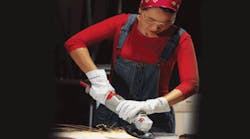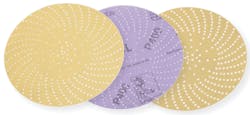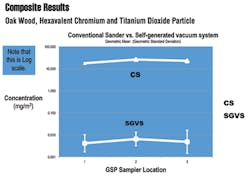Growing up, my dad showed me how to do a lot of things, like change a tire or change the oil on a car. But he wasn't into car body rust repair or woodworking, so I never learned to operate a power sander or learned the finer points of using sandpaper.
This learning gap didn't hold me back until I joined 3M's Abrasive Systems Division as a product steward. This role requires me to know the life cycle of a product – from how it's made on the factory floor, to how it's used on the customer's bench. Many people assume making sandpaper is easy. It's not, and that's the part I know better. The harder part is in understanding how a customer uses the products.
This past spring, I accompanied a new employee to a two-day product orientation course that included hands-on training. Being seven years on the job didn't qualify me as a new employee, but I saw the opportunity to hone my own skills.
First, I had trouble attaching the air hose to the power tools. Then I didn't hold steady, while sparks flew, which is another rookie indicator. As I tired from the physical work, my thoughts turned to the workers who sand day in and day out, thus prompting my "ah-ha moment." To invent an easier way to sand could make workers' jobs better. For example, in the woodworking business, many workers are women who would benefit from a lighter tool that is built with ergonomics in mind.
Life-Cycle Management
Life-cycle management is a formal part of many companies' product introduction process. Product stewards play a critical role in capturing, connecting and conveying health and safety stories from factory to customer, turning product features into user benefits. We consider all the environmental, health and safety implications of bringing a particular product into the world and throughout its life. When we develop a new product, we ask important questions from the start:
• How can we design it with ergonomics in mind?
• How will we manufacture it?
• How will a customer use it?
• How will end users dispose of it and the end of its life?
The story of 3M Clean Sanding System
This story is about how things get done through the diligence and collaboration of a dedicated team. The story begins with the disc.
The design and look of the discs are based on a shape created by Mother Nature called the logarithmic spiral – similar to a snail shell. The goal is to work with nature, not against it. The product designer wanted to create a sweeping action to contain dust and keep the abrasive clean, and incorporated natural shapes into the disc. He came up with many designs, but found a problem in scale-up and manufacturing. When the laser technology followed the logarithmic spiral design, the disc ended up with too big of a hole in the center.
The road from taking a creative idea to product conception – and innovation to commercialization – can be a long and winding one. The product developer persevered and combined logarithmic spirals in nature with a mathematical equation known as the Golden Ratio of 1.618. The best example of the Golden Ratio is the Parthenon (447 - 438 B.C.) in Athens.
By this time, other 3M employees had other ideas and competition ensued for resources. In order to prevail, the product developer needed reinforcement that he was on the right track. He took his disc to a custoAccording to the product developer, the customer picked up the disc and said, "This is really going to work well."
The developer asked him how he knew it was going to work before trying it out, and the worker said, "It looks like it will work," and it did. From that customer conversation, the product developer knew he had the right construction and design for the disc.
The vacuum bag is another interesting story. The same 3M product developer came up with a vacuum bag that looked like the tail of a platypus. When representatives from manufacturing looked at it, they saw waste. Cutting platypus tails from rectangles would mean lots of scraps to landfill. Together, the team redesigned the bag to a functional rectangular shape. The measurements are exact, so there is no waste. This example of life-cycle management with manufacturing's input spotlights that the best thinking happens when cross-functional parties work collectively.
The product design didn't stop here. By networking with yet another division, the Purification Division, researchers realized they could incorporate the same filtering technology used in furnace filters to make the bags even more efficient (HEPA-rated).
Science and Data
Data were needed to clearly demonstrate the effectiveness of the self-generating vacuum sanding system design. We wanted data to support a scientifically defensible claim. Our customers' safety professionals wanted a peer-reviewed publication to reference.
3M teamed with a University of Minnesota graduate student who pursued the project with 3M. Last fall, the article "Comparative Emissions of Random Orbital Sanding Between Conventional and Self-Generated Vacuum Systems" was published in the Annals of Occupational Hygiene.
This product is a commercial and economic success within a framework of environmental, social and economic values. It is an example of how a new product can be designed with input from product stewards, industrial hygienists and manufacturing and demonstrates why meeting sustainability goals depends on all of us to work together.
Sandy Wollschlager is a senior regulatory affairs specialist, 3M Abrasive Systems Division, in St. Paul, Minn.


